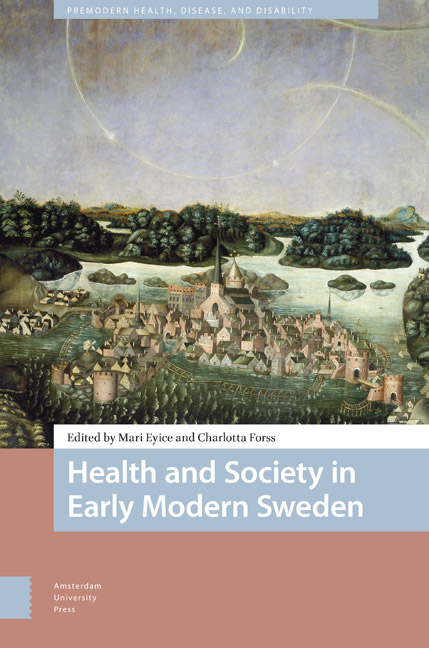Book contents
- Frontmatter
- Contents
- List of Tables and Figures
- Acknowledgements
- 1 Meanings of Health in Early Modern Sweden
- 2 Illness as Incapacity to Work in Early Modern Sweden
- 3 The Body in the Bathhouse: Health and Bathing in Early Modern Sweden
- 4 ‘Somewhat Heated, Quick and Lively’ : Humoral Explanations of the Learning Difficulties of Charles XI of Sweden (1655–1697)
- 5 Health in Body and Soul in a Female Birgittine Convent 1516–1522
- 6 Curing Madness and Mental Disturbances : Religious Healing Activities in Early Modern Swedish Local Communities
- 7 Not Quacks but Close : Reappraising the Role of Physicians on the Eighteenth-Century Medical Market
- 8 Gender, Health, and Hair in Sweden, 1740–1840
- 9 Gender Norms and Early Modern Healthcare : Barber-Surgeons in Sweden c. 1600–1900
- Epilogue : Epistemologies of Body and Soul: Considering the Early Modern and (Late) Modern History of Health
- Index
5 - Health in Body and Soul in a Female Birgittine Convent 1516–1522
Published online by Cambridge University Press: 16 April 2024
- Frontmatter
- Contents
- List of Tables and Figures
- Acknowledgements
- 1 Meanings of Health in Early Modern Sweden
- 2 Illness as Incapacity to Work in Early Modern Sweden
- 3 The Body in the Bathhouse: Health and Bathing in Early Modern Sweden
- 4 ‘Somewhat Heated, Quick and Lively’ : Humoral Explanations of the Learning Difficulties of Charles XI of Sweden (1655–1697)
- 5 Health in Body and Soul in a Female Birgittine Convent 1516–1522
- 6 Curing Madness and Mental Disturbances : Religious Healing Activities in Early Modern Swedish Local Communities
- 7 Not Quacks but Close : Reappraising the Role of Physicians on the Eighteenth-Century Medical Market
- 8 Gender, Health, and Hair in Sweden, 1740–1840
- 9 Gender Norms and Early Modern Healthcare : Barber-Surgeons in Sweden c. 1600–1900
- Epilogue : Epistemologies of Body and Soul: Considering the Early Modern and (Late) Modern History of Health
- Index
Summary
Abstract
This chapter analyses the perceptions of health of the early modern former spice merchant and Birgittine nun, Katerina Lemmel. At the monastery she entered at age fifty, they combined religious healing methods with humoral pathological methods. Katerina introduced spiced food, salutary drinks, and medication made of spices and a liquid binder. She considered the medicinal effects of using spices in these different ways as equivalent to traditional religious healing methods. They all promoted well-being and contentment, as well as strength. Nevertheless, whether one would remain healthy or recover from an ailment lay in the hands of God. However, an individual should contribute to their own well-being. First and foremost, one should eat the right foods but not abstain from food.
Keywords: spice treatments, healing methods, well-being, Birgittine Rule, bleeding
Introduction
This chapter is an attempt to elucidate how Katerina Lemmel, a newly widowed former spice merchant, who entered a Birgittine nunnary in 1516, perceived sickness and health. I aim to capture her beliefs and experiences, conceptions and comprehensions, of what people in those days called bodily and spiritual health. Furthermore, I examine by what means and methods what we call physical and mental ailments were prevented or combated in the female convent at Maria Mai in Maihingen, Germany. The two key questions I consider are: Were humoral pathological methods combined with religious ones? And how was God's impact on healing perceived?
I examine the ways in which Katerina contributed to the well-being of her sisters in the female convent, especially how she introduced luxury products such as spices, salutary drinks, and wine as healing products. I also study her view of the impact of faith on sickness, recovery, and death. Katerina's views and beliefs can be identified by reading her letters to her cousin, one of her former associates in the spice trading company that she had been a part of before entering the monastery Maria Mai in Maihingen in 1516. An analysis of her letters gives us, for the first time, an idea of how a nun – specifically a nun from the Swedish Birgittine order – experienced health and healing. She was not herself a healer, but a representative of the enlightened urban population. Throughout her professional life, she lived according to humoral pathological ideas, with the help of the family's own pharmacist.
- Type
- Chapter
- Information
- Health and Society in Early Modern Sweden , pp. 101 - 124Publisher: Amsterdam University PressPrint publication year: 2024



